Wisteria Tea House Introduction
Wisteria House is a teahouse, but it is more than just a teahouse; it is the first designated historical site in Taiwan and the first living historical site in Taipei that has been specifically designated for its cultural, historical spirit, and public space connotation. It has served as a gathering place for Taiwan’s democratic movement, opposition movements, and free scholars, emanating a cultural atmosphere that has educational, cultural, and political functions and characteristics, while strongly reflecting the significance of civic life culture and possessing preservation value. Wisteria House is an elegant wooden structure located in a concentration area of Japanese-style residences, originally built in the 1920s, featuring a unique courtyard with a tranquil and graceful environment. After the war, it was taken over by the Ministry of Finance and later turned into a teahouse by the descendants of the residents. The name "Wisteria House" stems from the old wisteria vine that stretches along the eaves of the house. The entire old house is filled with an artistic atmosphere, attracting many concerned individuals about current politics, avant-garde cultural and artistic workers who frequently gather here. Consequently, this place gradually became synonymous with liberalism and the space for social and political reform movements. To highlight the cultural value of Wisteria House, it was designated as a historical monument in 1997 after efforts from cultural figures and industry professionals, not due to the age of the tree or the house itself, but for its spiritual significance. (Source: Wisteria House)












